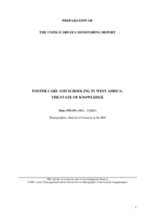childrens_living_arrangement
Displaying 11 - 19 of 19
UNICEF is seeking a Child Protection Specialist in Burkina Faso.
This article from the BBC tells the story of one family, and many others like it, in a small town in Burkina Faso where it has become customary for men to migrate to Italy for work, leaving wives and children behind.
This paper explores the effects of remittance receipt on child labour in an African context.
Cet article porte sur l’analyse de trois configurations institutionnelles de la protection de l’enfance : celle en place au Burkina Faso, en Belgique et au Québec. Pour chaque configuration, le texte explore les transformations qui ont marqué le passage de la prise en charge exclusive de l’enfant par la famille vers la présence accrue de l’État et la manière dont la Convention internationale des droits de l’enfant de 1989 a influencé ce passage.
Care related Concluding Observations adopted by the Committee on the Rights of the Child on the initial report of Burkina Faso under the Optional Protocol to the Convention on the Rights of the Child on the sale of children, child prostitution and child pornography.
Analyzes household decisions to send and receive children via fostering. Results show fostering used as a social protection mechanism to cope with income shock (sending) and address family labor shortages (receiving).
An executive summary of lessons learned on preventing family separation in poverty stricken communities. Brief case studies from Guatemala, Haiti, Philippines, United States and Burkina Faso.
Discusses the interplay between informal and formal safety net mechanisms in supporting orphans and children made vulnerable by HIV/AIDS. Includes recommendations for strengthening traditional family and community safety nets weakened by the epidemic.
Explores the relationship between fostering and education in West Africa. Identifies special need to focus on protecting and educating young girls.






